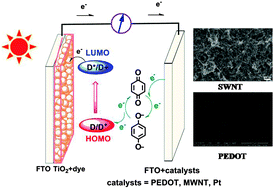Dye-sensitized solar cells based on hydroquinone/benzoquinone as bio-inspired redox couple with different counter electrodes
Abstract
In the present study, tetramethylammonium hydroquinone (HQ)/

Maintenance work is planned for Wednesday 1st May 2024 from 9:00am to 11:00am (BST).
During this time, the performance of our website may be affected - searches may run slowly and some pages may be temporarily unavailable. If this happens, please try refreshing your web browser or try waiting two to three minutes before trying again.
We apologise for any inconvenience this might cause and thank you for your patience.
* Corresponding authors
a
State Key Laboratory of Fine Chemicals, DUT–KTH Joint Education and Research Centre on Molecular Devices, Dalian University of Technology (DUT), 2 Linggong Rd., 116024 Dalian, China
E-mail:
yangxc@dlut.edu.cn
Fax: +86 411 84986250
Tel: +86 411 84986247
b
KTH Royal Institute of Technology, School of Chemical Science and Engineering, Department of Chemistry, Teknikringen 30, 10044 Stockholm, Sweden
E-mail:
lichengs@kth.se
Fax: +46 8 791 2333
Tel: +46 8 790 8127
In the present study, tetramethylammonium hydroquinone (HQ)/

 Please wait while we load your content...
Something went wrong. Try again?
Please wait while we load your content...
Something went wrong. Try again?
M. Cheng, X. Yang, C. Chen, J. Zhao, F. Zhang and L. Sun, Phys. Chem. Chem. Phys., 2013, 15, 15146 DOI: 10.1039/C3CP51980E
To request permission to reproduce material from this article, please go to the Copyright Clearance Center request page.
If you are an author contributing to an RSC publication, you do not need to request permission provided correct acknowledgement is given.
If you are the author of this article, you do not need to request permission to reproduce figures and diagrams provided correct acknowledgement is given. If you want to reproduce the whole article in a third-party publication (excluding your thesis/dissertation for which permission is not required) please go to the Copyright Clearance Center request page.
Read more about how to correctly acknowledge RSC content.
 Fetching data from CrossRef.
Fetching data from CrossRef.
This may take some time to load.
Loading related content
